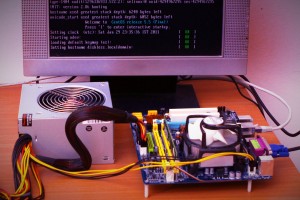Diskless booting implies that a client computer does not have any disk storage when booting an operating system. In that case, the computer can load the kernel as well as the root filesystem from a remote NFS server over network. It may use several different methods to load the kernel and the root filesystem from an NFS server: RARP, BOOTP or DHCP protocols. In this tutorial, I will use BOOTP/DHCP protocol because they are supported by many network cards.
Advantage of Diskless Computers
Imagine you have 30 computers in your office, all of which need to access the same application. If you are managing the computers as an administrator, what would you do? It will be a waste of your time if you install the application on every computer. On the other hand, a diskless system can eliminate the problem. With a diskless system, you just need to install the application on a central NFS server, and then boot all 30 clients over network.
Requirements
Two or more Linux computers equipped with network cards that support DHCP protocol. The computer that will act as an NFS server should have a hard drive, and the other client computer(s) do not need any hard drive. The server and client computer(s) need to be connected to the same local network.
There are five steps to setting up the diskless system.
Install required packages
Configure a TFTP server
Configure a DHCP server
Configure an NFS server
Booting diskless clients
In this tutorial, I assume that the computer which will run as a booting server is running Ubuntu. If you are using other Linux distribution, the principle is the same.
First Step : Install Required Packages
Use apt-get to install all necessary packages as follows.
$ sudo apt-get install dhcp3-server tftpd-hpa syslinux nfs-kernel-server initramfs-tools
Second Step : Configure a TFTP Server
TFTP server is a small FTP server which is needed for automated transfer of boot files between a client computer and server in the local network.
Add the following lines to /etc/default/tftpd-hpa
RUN_DAEMON="yes" OPTIONS="-l -s /var/lib/tftpboot/"
Next, create a boot directory.
$ sudo mkdir -p /var/lib/tftpboot/pxelinux.cfg
Copy the bootstrap ROM.
$ sudo cp /usr/lib/syslinux/pxelinux.0 /var/lib/tftpboot
Create a default boot configuration file as follows.
$ sudo vi /tftpboot/pxelinux.cfg/default
LABEL Ubuntu KERNEL vmlinuz APPEND root=/dev/nfs initrd=initrd.img nfsroot=10.10.101.1:/nfsroot ip=dhcp rw
Note:
“root=/dev/nfs” means the network filesystem on the server (doesn’t need to change).
“initrd=initrd.img” is a boot script for system startup.
“nfsroot=10.10.101.1/nfsroot” indicates the server’s IP address and the NFS share folder name. Substitute the IP address with your server’s address.
“ip=dhcp” means that client computers use DHCP addressing scheme.
“rw” means that the NFS share is read/write.
Finally, restart the TFTPD service.
sudo /etc/init.d/tftpd-hpa restart
Third Step : Configure DHCP Service
You also need to configure DHCP service on the NFS server to allow booting with /var/lib/tftpboot/pxelinux.0. Your configuration might look like the following, assuming you using subnet 10.10.101.0.
$ sudo vi /etc/dhcp3/dhcpd.conf
allow booting;
allow bootp;
subnet 10.10.101.0 netmask 255.255.255.0 {
range 10.10.101.2 10.10.101.254;
option broadcast-address 10.10.101.255;
option routers 10.10.101.1;
filename "/pxelinux.0";
}
Then restart DHCP service.
$ sudo service isc-dhcp-server restart
Fourth Step : Configure an NFS server
Create a directory that holds the client root filesystem.
$ sudo mkdir /nfsroot
Next, configure the NFS server to export the client root filesystem. For that, add the following line to /etc/exports.
/nfsroot *(rw,no_root_squash,async,insecure,no_subtree_check)
Run the following command to reload modified /etc/exports.
$ sudo exportfs -rv
By default, Ubuntu does not add network boot support to the initrd image. Thus you need to create a new initrd.img file. For that, first add the following line to /etc/initramfs-tools/initramfs.conf
BOOT=nfs MODULES=netboot
Then run the following command to create a new initrd.img.
$ sudo mkinitramfs -o /var/lib/tftpboot/initrd.img
Copy the new kernel image to /var/lib/tftpboot.
$ sudo cp /boot/vmlinuz-`uname -r` /var/lib/tfftpboot/vmlinuz
Now it is time to copy the entire root filesystem to /nfsroot.
Assuming tgat you are using a fresh Ubuntu server installation, you just need to clone the server filesystem to the NFS root.
$ sudo cp -ax / /nfsroot
Then open /nfsroot/etc/fstab with a text editor to add the following line.
/dev/nfs / nfs defaults 1 1
The directory /var/lib/tftpboot should have world read/write permissions. Otherwise the client would not be able to boot from network.
$ sudo chmod -R 777 /var/lib/tfftpboot
Lastly, to avoid any misconfiguration on the server, I recommend using a static IP address for the interface which DHCP service is running on. For example, if its network interface is named eth0, your configuration in /etc/network/interfaces should look like this:
iface eth0 inet static address 10.10.101.1 netmask 255.255.255.0 broadcast 10.10.101.255 network 10.10.101.0
Fifth Step : Booting a Diskless Client
After you completed the configuration on the server. Boot your client from network. To boot from network, you typically need to change the boot order priority in your BIOS configuration.


